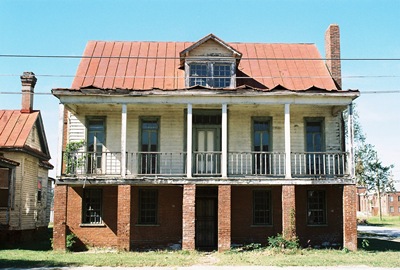
Back in 2005, I wrote a post called Access Denied in which I described why I hadn’t photographed a particular part of Augusta, Georgia. This area included streets to the south of Walton Way and north of Laney-Walker Boulevard, bounded by Augusta’s famed medical colleges to the west and East Boundary to the, uh, east. Historically, this rectangle of neighborhoods was known as “The Terry,” a contraction of “Negro Territory.” This is where James Brown grew up and, at the time, I lamented not feeling that I could safely visit Twiggs St., where his childhood home had been, as I’d been told it was amongst Augusta’s “poorest and most dangerous neighborhoods.” I’d heard rumors ranging from the streets being unpaved to police not bothering to patrol. I sheepishly mentioned that I had at least driven through those streets. And they did appear to at least be paved.
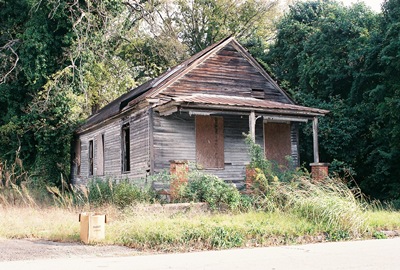
A short while after I posted that piece, a commenter took me to task for not only believing what I’d been told, but for letting my wariness get in the way of visiting some historic places and taking some photos. This person dispelled many of the rumors and told me of the friendly, hard-working people that lived in the vicinity. The commenter wrapped-up by inviting me to visit these neighborhoods with them and see for myself the streets they‘d known most of their life. Of course, they were absolutely right. Mostly.
While my visits to Augusta since have been brief, not allowing me the time to contact the commenter and see if their offer still stands, I have gotten to know the neighborhoods I was referring to rather well. I even did an entire post on the address where James Brown grew up, his actual home, which also housed his aunt’s brothel, having long-since been torn down.
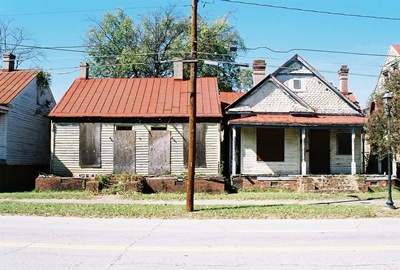
In Access Denied, I referenced “Stranger with a Camera,” a documentary about a film crew that ventured into rural Kentucky in the 1960’s to juxtapose the poverty there with footage they’d captured in more affluent parts of the country. While some people were happy to be filmed, hoping that the exposure might bring attention and federal aid, others were not so thrilled to have outsiders meddling in their business. On the last day of filming in Letcher County, Hobart Ison, a landlord who owned some houses where families were being interviewed, shot at the crew, killing Scottish Canadian photographer Hugh O’Connor. Ison was never convicted of any wrongdoing, the photographer, after all, having been on his property.
“Stranger with a Camera,” is required viewing for anyone interested in the fine line between documentation and exploitation, empathy and intrusion. Many of the messages of the film remain pertinent, among them this: “If you have a camera, be careful where you point it.” While it might have been silly of me to be intimidated by the things I’d heard about The Terry, that doesn’t mean that prudence was unwarranted. If that was the case in the neighborhoods I just described, it’s even more true farther south on Twiggs, where the historic Dr. Scipio S. Johnson House can be found.
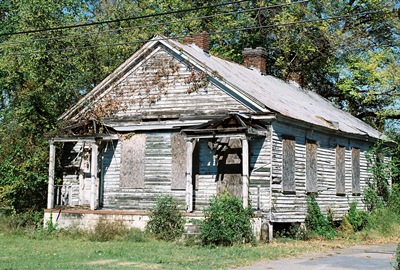
Located in a part of Augusta known as the Bethlehem Historic District, this stretch of Twiggs, near where it becomes Martin Luther King, Jr. Blvd, is about as blown out a collection of streets as a person could find. The reasons include the usual socio-economic ones that plague many American cities. The history of this district is indeed rich, as described by the National Park Service in a piece that doesn't quite show the whole picture, I'd say. I would certainly love to know more about the district and the fascinating buildings that line its streets, now mostly empty shells. But this is where I have to depart from my commenter just a bit. For me to blithely roam around Old Savannah Rd. or 12th St. or parts of Wrightsboro Rd. on my own, poking my head in the open doorways of vacant buildings, rental car parked at the end of the street, camera around my neck, would be a kind of naivety that I’m just not a fan of. It might even be disrespectful. But I had a look at the S. S. Johnson House, feeling much as I did when I heard the stories of the film crew in Kentucky, “If something goes wrong, at least you shouldn’t say that you didn’t know what you were getting into.”
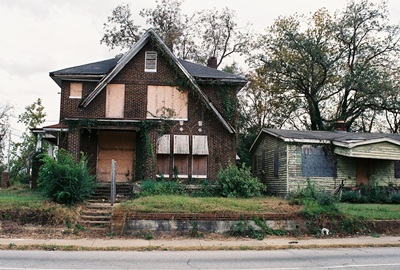
Now, Scipio S. Johnson was an African-American doctor who lived at 1420 Twiggs St. (pictured above) from the time the house was built in the 1920’s until his death in 1932. Dr. Johnson was a graduate of the Haines Institute, the Lincoln Institute, and Georgetown University. Nearby Johnson St. is, in fact, named for him. He was also a pharmacist and for a time ran a drug store right out of 1420. The two-story, Craftsman-style brick home is one of the largest in the Bethlehem District but it’s in pretty bad shape. The windows, which were considered historic in themselves, have been replaced by plywood. At least the boards were nailed-up tight enough not to tempt me. And that second story porch in the photo below is rather rickety. Who knows what’s gone on inside at this point? In late 2011, the house was added to Historic Augusta’s Endangered Properties List.
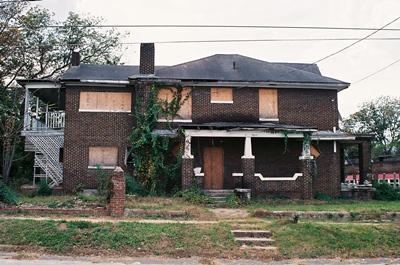
However, there is hope for the place. The Augusta, Georgia Land Bank Authority currently owns the property and intends to restore it as part of the Laney-Walker/Bethlehem Revitalization Project. That project will preserve another historic structure on Twiggs, the W.S. Hornsby House, while removing many adjacent structures. The plan calls for Twiggs St. to eventually be widened and the surrounding streets to be included in a “Twiggs Circle” development. Whether this will play out to the ultimate good of those who currently live in the area is anyone’s guess, but the problems have certainly attracted attention. In the meantime, if that commenter happens to read this: I’d still like to take you up on your offer of a tour, but maybe we could also check out some of the Bethlehem Historic District. It sounds like many of these buildings aren’t long for the world. Any chance?
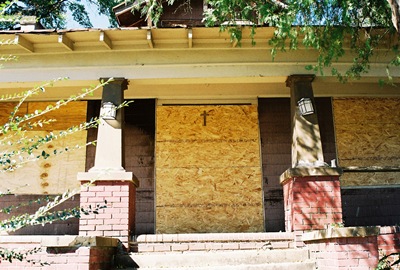
Information for this post came from Historic Augusta and the Augusta Chronicle’s piece on the Laney-Walker/Bethlehem revitalization plan. The photos were all taken on or near Twiggs St. The shot at the very top is of the Denning House at 905 7th St., just before 7th becomes Twiggs. Built in the 1860's, it was on Historic Augusta's 2007 Endangered Properties list and looked a little better back then.
Who would’ve thought I’d come back from a few days in Augusta with so much material? Next time we’ll head back north a few streets to 811 D’Antignac, a vacant house built in 1870 which served as a consolation prize for me after my main structure of interest was torn down.
No comments:
Post a Comment